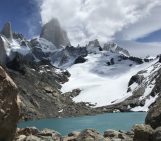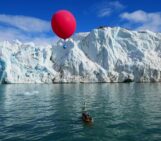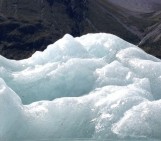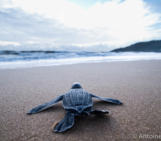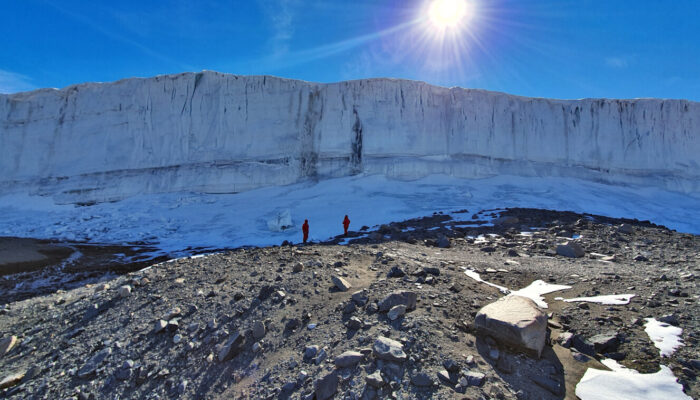
Hi Ronja and Emily, thank you for agreeing to doing this interview. Could you tell us briefly about your background and how you came to research your field?
Emily: I have an environmental science/physical geography background and I have been working with an ice sheet model during and after my PhD to understand how glaciers and ice streams in Greenland and Antarctica may respond to climatic changes. I’m currently a postdoctoral research fellow on the EU funded Horizon 2020 project TiPACCs or “Tipping Points in Antarctic Climate Components” (which funded the work of the two papers). I’m based at Northumbria University in Newcastle, UK. I’m generally passionate about the environment and it was doing some field research on a glacier in the Italian Alps that first got me hooked on glaciology, and better understanding these environments. More broadly, research is fun, and ice loss due to climate change is topical, which is one of the personal motivations I have – it’s important work!
Ronja: With a background in maths, I did my PhD and a PostDoc in climate physics at the Potsdam Institute for Climate Impact Research in Germany. During this period, I used and developed numerical models to understand ice dynamics in Antarctica. Currently, I’m a Vice Chancellor’s Fellow in Glaciology, also at Northumbria University in Newcastle, UK. Together with Emily, I have been working on TiPACCs. In this project, we work closely with colleagues from Europe which has been great fun. I’m passionate about mathematical applications for real-world systems, and the Antarctic Ice Sheet is particularly interesting to me – I had a chance to go there once. It is an incredibly remote place, but still ice loss there affect coast regions in every corner of the world.
Your recently published studies – part 1 and part 2 to be precise – are a first-of-its kind analyses of the current state of the Antarctic ice sheet. Would you say that your findings were encouraging? Why?
Ronja: We know that the ice sheet in West Antarctica has the potential to collapse. And at the moment, glaciers in Antarctica, in particular in the Amundsen Sea in West Antarctica, are retreating. This has raised concerns that such a collapse is already under way. In our study, we look into this question – and find that there is no indication of irreversible retreat or collapse – yet.
Emily: One of the key conclusions of our first paper is indeed that the Antarctic ice sheet has probably not entered a phase of self-enhancing, irreversible retreat just yet.
That’s somewhat encouraging, to know that there is a very small window of opportunity to prevent the Antarctic ice sheet to cross a tipping point, but only if we were to take urgent action.
But the findings of our second study are not so positive, and this is a key message, while we might not have reached a “point of no return” just yet, even if climate conditions stay the same as they are today, we will eventually reach that point of no return, and the West Antarctic ice sheet could collapse. That’s not good news at all.
Even with no additional warming beyond current levels, your team found that an irreversible collapse of some marine regions of West Antarctica’s ice sheet is still possible. What are the implications of such collapse?
Ronja: This is the second part of our analysis: we find that even without further warming, irreversible collapse of some marine regions in West Antarctica is possible. This means that the critical temperature level, at which collapse occurs, has likely already been crossed today. The collapse would eventually raise global sea levels by around 3 meters, in our model. But importantly, it starts in the future and evolves over millennia. In our analysis, we did not include some processes, such as calving of icebergs, that could speed up the process. And we did not analyse the effect of further global warming. Based on studies of colleagues, we would expect that further warming will substantially speed up this process.
Emily: The findings of the second paper are certainly more worrying than the first. It seems unlikely that we (society) would suddenly be able to halt warming and keep it at present day levels into the future, this means that we could be destined to see a collapse of some parts of the West Antarctic ice sheet, and this would contribute substantially to global sea level rise, with implications for coastal communities worldwide. Of course, because ice sheets respond slowly to external forcing this will take a very long time to occur, and the earliest we found this to happen was 300-500 years, but as Ronja says, if we experience further warming, that exceeds the levels of present day, the time at which the West Antarctic ice sheet crosses a tipping point could happen much sooner.
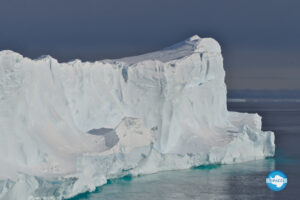
Ice front of the Brunt Ice Shelf, Antarctica. This picture was taken in 2018, since then, this part has calved off.
In today’s world, what sort of climate mitigation efforts would it take to delay or prevent crossing a tipping point? And what scale would these efforts need to be?
Emily: Our results show that to prevent a collapse of the West Antarctic ice sheet, it would not be sufficient to just halt further warming. In our model, we would actually need to decrease warming to previous (pre-industrial) conditions. This would require a huge global effort to achieve this.
Ronja: Our study offers a small window of hope in the sense that the tipping point for West Antarctica has not been crossed already, in contrast to previous worries. There is hence a little wiggle room to delay the onset of collapse.
Our model shows large uncertainty about the onset of irreversible retreat in the hypothetical case that current climate would remain as it is. Future work should explore this more, together with including the effect of future warming.
Were there any findings during your study that surprised you?
Emily: Given that previous studies have suggested that parts of the West Antarctic ice sheet may have already crossed a tipping point, it was perhaps surprising to us that our simulations showed that this isn’t the case just yet. It was also a little surprising that all our models showed consistent results. Given that they are initialised slightly differently, there is always the potential for different results, but it was encouraging to see all our results were the same across all models.
Ronja: To test long-term stability, we created an ensemble of simulations that represent present-day Antarctica with varying model parameters to capture known uncertainties. I was surprised that we found eventual collapse in all of our model configurations.
Finally, what’s next for both of you in terms of research or future projects?
Ronja: I want to understand stability in the context of ice-ocean interactions. So far, we have analysed the stability of the Antarctic ice sheet. At the moment, ice loss in Antarctica is caused by changes in ocean-driven melting, and we know that also the ocean surrounding the ice sheet can undergo regime shifts. As a next step, I want to analyse the interplay of regime shifts in the ocean and collapse in the ice sheet to understand if they enhance or dampen each other.
Emily: Similar to Ronja, I’m interested in whether tipping points in the ice sheet can be arrived at sooner if there are sudden changes to the melt rates beneath the ice shelves, driven by changes in ocean conditions. More broadly there are many people on the TiPACCs project who are addressing similar questions around the potential for ice-ocean tipping points.

